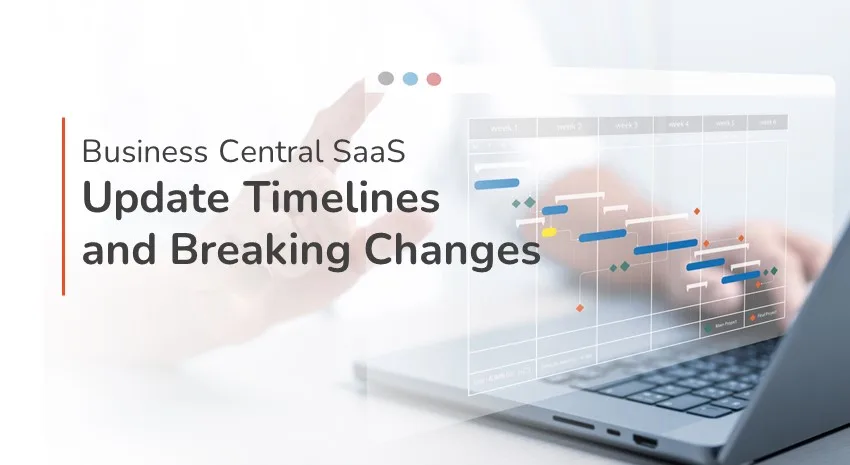Navigating Business Central SaaS Update Timelines: A Guide to Smooth Migrations and Upgrades

For years, we have advised clients running older versions of Dynamics NAV or Business Central on-premises to migrate to Business Central using a Software as a Service (SaaS) model. While some business users might still want to keep running their Business Central on premises, all Business Central deployments must be cloud-compliant to avoid additional charges, whether on-prem or cloud.
In this blog, we would like to explain how the Business Central SaaS release model works, what you can expect after moving to the cloud, and how ArcherPoint can help navigate you through any rough patches you might encounter.
The Dynamics 365 Business Central release schedule
The advantage of a SaaS (Business Central online) deployment model is that everyone runs the same version of the code, so you are always up to date. Customizations and ISV products use “extensions” to add features and functionality to the base code.
Microsoft issues a major release of Business Central every six months in Spring and Fall (known as Wave 1 and Wave 2). The current release is 2023 Wave 2, with 2024 Wave 1 coming soon. Minor releases are issued throughout the year.
Microsoft offers BC SaaS users a two-week preview of the upcoming release so Business Central developers, Microsoft partners, and Independent Software Vendors (ISVs) can see the new release before upgrading their clients. Release notes and documentation are also available so partners, ISVs, and users can know what areas of the software are being affected, determine if the changes will affect them, and begin preparing tests to ensure the release will not impact them.
A two-month window follows the preview period so users can test the new release and identify any issues that must be resolved before the production code is updated.
Business Central users can test the new release in a safe environment, or “sandbox,” without affecting their production system. Sandboxes can also be used to try out new add-ons, test customizations, and run performance tests without affecting their day-to-day operations.
Once the business is satisfied that the new release will work without causing interruptions or problems, Microsoft will move ahead with upgrading its system.
The two-month testing period is followed by a two-week grace period. Any outstanding issues that would cause a business to delay the upgrade to the new release must be resolved by the end of this grace period before Microsoft will update the software automatically. Non-compliant or breaking code will be disabled.
Sometimes things go wrong
There are times when customizations, automation scripts, or add-on products, whether written by a partner, an ISV, or the customer, break when the new release is installed. These incidents (or “breaking changes”) can occur after a major release because Microsoft is constantly adding new functionality and adopting the latest technologies, which can make old custom code incompatible with the new Microsoft Code, even though most partners, ISVs, and experienced developers have adopted Microsoft’s Business Central Universal Code Initiative.
Finding and fixing the offending code often requires technical skills that are beyond the capabilities of most business users and their development staff. In that situation, the natural recourse is to bring in a Microsoft Business Central partner.
Get current, stay current
ArcherPoint offers several support plans to help Business Central users get to the cloud and stay current. We help our clients resolve any issues related to breaking changes and ensure they can adopt each upcoming release without incident.
ArcherPoint offers three upgrade plans: Basic, Essential, and Advanced.
Our upgrade process follows the following steps, with some minor variations depending on the specific plan the company selects:
- Every time there is a major release, ArcherPoint receives a preview.
- We inform the customer the preview is available and that an upgrade is coming, so the business has time to prepare their team for the upgrade.
- We run our pipelines against the latest version for each customer and find any compatibility issues or errors. If any issues are found, we inform the customer.
- The customer can then set up a sandbox. We will download the latest production environment and update the sandbox to the latest version, and they can run their tests during the two-month testing phase. We will send reminders during the testing period to make sure the customer completes compatibility testing. Customers should devote a team to test the updates.
- Based on the plan the customer is on, the upgrade team will fix any issues that originated on our end or, if the problem is with customer-developed code, help the customer resolve the problem. If the problem originated with an ISV or another partner, we help the customer as much as possible to contact the company and try to resolve the problem.
- Once given the approval of the client, we move forward with updating the production environment.
What about deprecated code?
Occasionally, Microsoft will disable functions in the base code (“deprecated code”). Deprecated code is disabled by default, and Microsoft offers alternate functionality to replace it. Developers are informed and are given three release cycles (one-and-a-half years) to replace any deprecated code to the alternate functionality. After that time expires, the deprecated code is removed, which might cause a breaking change.
We’ve been doing this a long time
If you are having problems with your Dynamics NAV or Business Central upgrade, contact ArcherPoint. We have been helping clients upgrade from any version of Navision, Dynamics NAV, or Business Central for over twenty years. We have automated much of the process, eliminating the manual time consuming steps so we can apply our technical expertise for code refactoring, reconfiguration, and coordinating with ISV partners.
